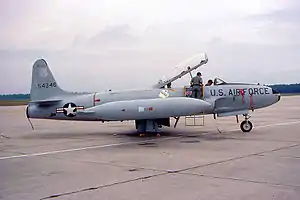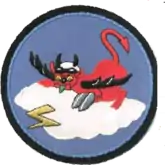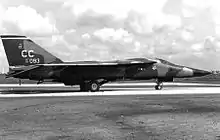465th Tactical Training Squadron
The 465th Tactical Training Squadron is an inactive United States Air Force unit. During World War II as the 465th Bombardment Squadron, it was an operational and replacement unit from 1942 to 1944, when it was disbanded in a general reorganization of Army Air Forces training and support units in the United States. The squadron was reconstituted as the 465th Tactical Fighter Training Squadron in 1973 and briefly operated the General Dynamics F-111 Aardvark at Cannon Air Force Base, New Mexico. It moved to Holloman Air Force Base, New Mexico and operated as a fighter and academic training unit until inactivating in 1991.
465th Tactical Training Squadron
 | |
|---|---|
 T-33 used for training of air controllers | |
| Active | 1942–1944; 1972–1991 |
| Country | |
| Branch | |
| Part of | Air Combat Command |
| Motto(s) | Respice Tuo Sex Latin Check Six |
| Engagements | American Theater of Operations without inscription |
| Decorations | Air Force Outstanding Unit Award[1] |
| Insignia | |
| 465th Tactical Training Squadron emblem |  |
| 465th Bombardment Squadron emblem (approved 22 June 1943)[2] |  |
History
World War II

The 27th Bombardment Group had engaged in combat in the Southwest Pacific Theater, both in the air with Douglas A-24 Banshees and on ground as infantry in the Philippines. In May 1942, the group and its three squadrons were withdrawn from the theater and moved on paper to Key Field, Mississippi, where it began reforming as a Douglas A-20 Havoc unit.[3] To bring the group to its full strength, the squadron was activated in July 1942 as the 465th Bombardment Squadron. In addition to A-20s, the squadron also was assigned a few DB-7 export versions of the Havoc[2]
In the fall of 1942, the 27th Group prepared for movement to North Africa, but would be converted to a fighter-bomber unit flying North American A-36 Apaches.[3] Because Army Air Forces (AAF) fighter-bomber groups were assigned only three squadrons, when the group moved overseas in late November 1942, the 465th was reassigned to III Air Support Command, and became an Operational Training Unit (OTU).[2] The OTU program involved the use of an oversized parent unit to provide cadres to "satellite groups".[4]
In January 1943, the squadron moved to Alachua Army Air Field, Florida, where it became part of the Army Air Forces School of Applied Tactics. In addition to training cadres for newly-formed groups it also demonstrated tactics for light bomber units as part of the 415th Bombardment Group.[5] In March 1944 the group moved to Dalhart Army Air Field, Texas, where it became a Replacement Training Unit.[2] Replacement Training Units were similar to OTUs in that they were oversized units, but their mission was to train individual pilots or aircrews.[4] However, even as the squadron arrived at Dalhart, the AAF was finding that standard military units, based on relatively inflexible tables of organization were not proving well adapted to the training mission. Accordingly, a more functional system was adopted in which each base was organized into a separate numbered unit.[6] The 415th Group, including the squadron, and support units at Dalhart were disbanded,[2][5] and their personnel and equipment were reorganized as the 232d AAF Base Unit.
Tactical Air Command

In the fall of 1972, the squadron was reconstituted as the 465th Tactical Fighter Training Squadron and reactivated on 1 December at Cannon Air Force Base, New Mexico, where it trained crews on the General Dynamics F-111 Aardvark as part of the 27th Tactical Fighter Wing.[7][8] This mission lasted only eight months, and in August 1973, the squadron moved to Holloman Air Force Base, New Mexico, where it conducted lead in fighter training with the Northrop AT-38 under the 49th Tactical Fighter Wing.[9][10] In January 1977, flying training activities at Holloman were put under the newly-activated 479th Tactical Training Wing. The squadron was transferred to the 479th Wing, where it performed the academic training portion of the wing's mission. It continued this mission until it was inactivated in 1991, when its mission, personnel and equipment was transferred to the 435th Tactical Training Squadron.
Lineage
- Constituted 465th Bombardment Squadron (Light) on 7 July 1942
- Activated on 13 July 1942
- Disbanded on 5 April 1944[11]
- Reconstituted on 27 October 1972 and redesignated 465th Tactical Fighter Training Squadron
- Activated 1 December 1972[note 1]
- Redesignated 465th Tactical Training Squadron on 1 January 1977
- Inactivated on 19 February 1991[12]
Assignments
- 27th Bombardment Group, 13 July 1942
- III Air Support Command, 21 November 1942
- Army Air Forces School of Applied Tactics, c. 22 January 1943
- 415th Bombardment Group, 23 March 1943 – 5 April 1944[11]
- 27th Tactical Fighter Wing, 1 December 1972[7]
- 49th Tactical Fighter Wing, 1 August 1973[10]
- 479th Tactical Training Wing, 1 January 1977 – 19 February 1991[12]
Stations
- Key Field, Mississippi, 13 July 1942
- Hattiesburg Army Air Field, Mississippi, 15 August 1942
- Harding Army Air Field, Louisiana, 26 October 1942
- Alachua Army Air Field, Florida, 24 January 1943
- Montbrook Army Air Field, Florida, c. 19 November 1943
- Orlando Army Air Base, Florida, 2 March 1944
- Dalhart Army Air Field, Texas, 19 March-5 April 1944[11]
- Cannon Air Force Base, New Mexico, 1 December 1972[8]
- Holloman Air Force Base, New Mexico, 1 August 1973[9] – 19 February 1991[12]
Aircraft
Awards and campaigns
| Award streamer | Award | Dates | Notes |
|---|---|---|---|
| Air Force Outstanding Unit Award | 1 January 1976-31 December 1976 | 465th Tactical Fighter Training Squadron[1] | |
| Air Force Outstanding Unit Award | 1 May 1981-30 April 1983 | 465th Tactical Training Squadron[1] |
| Campaign Streamer | Campaign | Dates | Notes |
|---|---|---|---|
| American Theater without inscription | 13 July 1942 – 5 April 1944 | 465 Bombardment Squadron[2] |
References
Notes
- Explanatory notes
- During the entire time the squadron was active as the 465th Tactical Fighter Training Squadron, an unrelated 465th Tactical Fighter Squadron was active in the reserve.
- Citations
- "Air Force Personnel Services: Unit Awards". Air Force Personnel Center. Retrieved 17 September 2018. (search)
- Maurer, Combat Squadrons, p. 571
- Maurer, Combat Units, pp. 78-81
- Craven & Cate, Introduction, p. xxxvi
- Maurer, Combat Units, p. 299
- Goss, p.75
- Ravenstein, pp. 49-52
- Mueller, p. 62
- Mueller, pp. 250-251
- Ravenstein, pp. 78-81
- Lineage, including aircraft, assignments and stations, through 1944 in Maurer, Combat Squadrons, p. 571
- Tactical Air Command Special Order GB-28, 14 February 1991
Bibliography
![]() This article incorporates public domain material from the Air Force Historical Research Agency.
This article incorporates public domain material from the Air Force Historical Research Agency.
- Craven, Wesley F; Cate, James L, eds. (1955). The Army Air Forces in World War II (PDF). Vol. VI, Men & Planes. Chicago, IL: University of Chicago Press. LCCN 48003657. OCLC 704158. Retrieved 17 December 2016.
- Goss, William A. (1955). "The Organization and its Responsibilities, Chapter 2 The AAF". In Craven, Wesley F.; Cate, James L. (eds.). The Army Air Forces in World War II (PDF). Vol. VI, Men & Planes. Chicago, IL: University of Chicago Press. LCCN 48003657. OCLC 704158. Retrieved 17 December 2016.
- Maurer, Maurer, ed. (1983) [1961]. Air Force Combat Units of World War II (PDF) (reprint ed.). Washington, DC: Office of Air Force History. ISBN 0-912799-02-1. LCCN 61060979. Retrieved 17 December 2016.
- Maurer, Maurer, ed. (1982) [1969]. Combat Squadrons of the Air Force, World War II (PDF) (reprint ed.). Washington, DC: Office of Air Force History. ISBN 0-405-12194-6. LCCN 70605402. OCLC 72556. Retrieved 17 December 2016.
- Mueller, Robert (1989). Air Force Bases, Vol. I, Active Air Force Bases Within the United States of America on 17 September 1982 (PDF). Washington, DC: Office of Air Force History. ISBN 0-912799-53-6. Retrieved 17 December 2016.
- Ravenstein, Charles A. (1984). Air Force Combat Wings, Lineage & Honors Histories 1947-1977. Washington, DC: Office of Air Force History. ISBN 0-912799-12-9. Retrieved 17 December 2016.

